Karnataka has always set the right tone for a walk through India’s age-old culture and craftsmanship. One among such places of great historical and cultural importance is Badami (Vatapi).
The town is like a masterpiece sculpted out of ancient red sandstone. Accentuated by the holy Agastya Lake around the town, it’s a timeless heritage centre.
The royal capital of the Chalukyas from 540 AD to 757 AD, you can locate this alluring town in the Bagalkot district of North Karnataka.
Adorned by intricate Dravidian architecture and relief work, the monuments here are a reflection of the surreal magic the town holds.
The temperature variations are not much, and so a visit round the year is favourable.
How to reach
Air travel is facilitated through Hubballi airport which is at a distance of 100 kilometres from Badami.
An easier mode of transport would be the rail lines connecting to Badami. The Badami railway station is barely at a distance of 5 km from the town. You can choose to take a rickshaw or walk the distance till there.
The Bagalkot Junction Railway station is also accessible at a distance of 33 km.
Since it’s a government-approved heritage site, there are common buses available from Bangalore as well. The bus ride would take a duration of 11-13 hours during no rush hours.
From the infamous architectural spectacle, Hampi, the town is marked 150 km
If you’re driving to Badami, assuming that Bangalore City would be the starting point, you’d have to cover an approximate distance of 425 km.
Bangalore – Chitradurga – Hubli (NH4) – Nargund – Badami
Why Badami?
Undoubtedly, Badami’s high sandstone cliffs are why you have to put up the town on your must-visit places. A popular free sport climbing and bouldering spot, the cliffs have established a reputation of having safe climbing routes.
The crack systems and the bolted routes are often compared to the premier climbing areas of the Shawangunks in the West.
With above 150 bolted routes of varying difficulty levels, its the perfect spot for beginners as well as a challenging climb for experienced rock climbers.
I had chosen the climb from Saraswati area, a lesser explored site almost 700m from Badami bus station. With the help of a reliable instructor, I managed to climb through the bolted routes. The view while I was hanging midway with the rope attached, is something I’d not want to trade in return for any other experience. On having reached the topmost point, I was rewarded with a 360° view of the plantations and the water bodies that stood still with time. I had earlier missed out on all these while being engrossed in the Dravidian architecture.
This point was also quite intimidating due to its towering height, but the instructor assured me that unlike Granite, sandstone is not of high impact.
There are other areas as well such as the Ganesha area, Delux area, Kannaragavi area, and so on, not farther away than 3 km from the Badami bus stop.
Yet another activity at Badami that you cannot miss out on, is the trek across temples and monuments here. There are easy walks of 2-3 hours from North fort to the temples. Then there are the treks that will keep you engaged for the entire day, based on your interest in trekking you can choose either one of the options.
Spottable around here
Big things come in small packages.
This was my exact thought while exploring the humble town of Badami. There is no dearth in the feast this small town arranges for the eyes of the visitors every day.
1. Badami Cave Temples
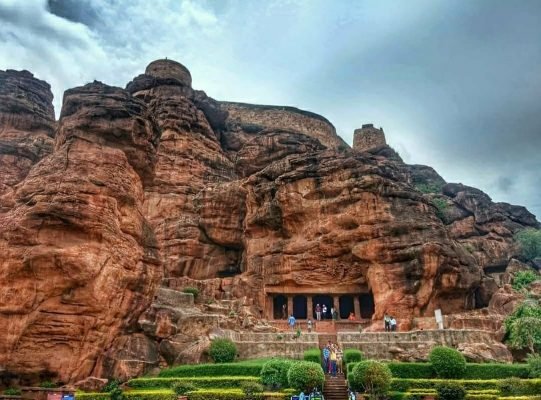
Magnificent rock-cut architecture with Chalukyan inspired carvings, the Cave temples are definitely what brings in the crowd to Badami.
It’s the converging point of different cultures and traditions. The Cave temple is an umbrella structure for four beautiful temples. Three of which worship Hindu deities and the other is dedicated to the practice of Jainism. These temples are not dissected as four parts, instead form a network through a flight of stairs that connect each temple to the other.
A very noticeable feature of these temples is the Dravidian architecture from the South combined with the Nagara architecture from the North. It’s what I love to label as the best of both worlds.
Nataraj, Vishnu, and Mahavira are few among the deities who are worshipped here.
A walk around the temple would be a feast to your eyes. An exemplar of astounding craftsmanship, don’t miss out on the remarkable relief works and paintings on the ceilings and pillars. The ceilings, in particular, are engraved with the infamous picture of the trio Vishnu, Shiva and Brahma bordered with the lining of stalks of lotus flowers.
Open during the hours of 9 am to 5’30pm, the temple is a must-visit architectural spectacle in Badami.
2. Mallikarjuna Group Of Temples
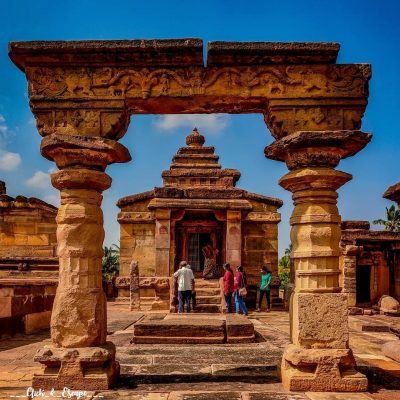
A place that should definitely fall on your itinerary to Badami, are the Mallikarjuna temples adjacent to the infamous Bhootnath temples. An early morning visit to these temples would leave you at a loss of words. That’s just how mesmerising the sandstone sculptures look when the first rays of the day shimmer over it.
Opened for a public visit during the hours of 5’30 am-1’00 pm and again from 3’00 pm-7’00 pm in the evening.
These temples in particular are quite unique with their pyramidical framework. Established by the Chalukyas, the temple is dedicated to Lord Shiva.
A very important heritage site in Badami, the place is embedded by many small shrines constructed during the reign of Kalyani Chalukyas and Rashtrakutas.
People with immense interest in architecture and history would be left under a spell looking at the Phansana styled Shikharas.
The creamy layer to the charm of this stone structure is the hues of Agastya Lake surrounding the temple premises.
3. Badami Fort
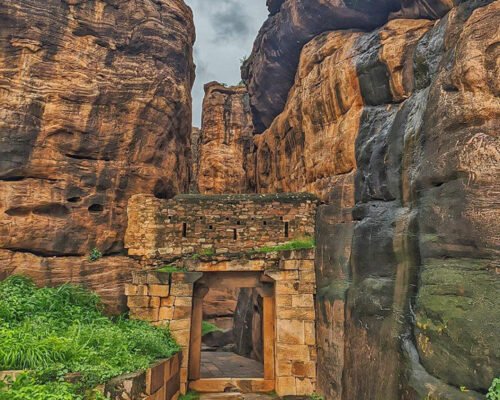
Subtlety wraps this towering structure like a vine. A 2km trek from the main town, this fort is an untouched reflection of the vast South India history.
Established and fortified by King Pulakeshi, the tower was destroyed by the Pallavas and remained in ruins for a really long while.
Later on, the walls of the fort were rebuilt on, and the entire structure was polished up to look like before. After which it was opened for tourist visits with a minimum fee of Rs 5.
The fort is placed in such a way that the view from here offers you an absolute view of the entire town. Not like miniatures, but a very up-close view.
Large granaries, watchtowers, underground chambers, all planned and placed strategically. It’s impossible to not admire the thought and effort that went behind in creating such stunning structures.
The kings have double fortified the fort, to ensure lesser safety and security breaches. You can also spot large dust sieved cannon that is said to have witnessed numerous attacks on the fort.
A fascinating architecture right near the archaeological fort is that of a masjid built by the great Tipu Sultan.
4. Archaeological Museum

If there was a summary of what this place looked like to me, it’d be this,
National Treasure.
That’s what the Badami Archaeological museum is. A treasure within the carved antiquity in the form of a museum.
Even though built around the year of 1979, it was transformed to cater to the increasing number of tourists by the year 1982. Located close enough to the Badami Fort, the Museum is now trekkable from all the major tourist places around here.
On entering the gates, you’d be welcomed by an idol of Nandi. The museum has four galleries, out of which two are open galleries.
Most of the exhibits around here are deeply rooted with mythology and legacies. There are multiple representations and interpretations of the Hindu gods, Lajja-Gauri, scenes from the Bhagwat Gita, inscriptions from 6th to 16th centuries and so much more!
Watching the sunset at Agastya Lake in Badami is an oddly calming experience.
5. Agastya Lake
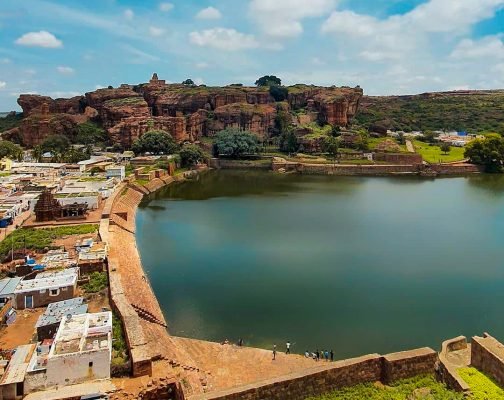
Watching the sunset at Agastya Lake in Badami is an oddly calming experience. With the scenic rock hills as a curtain, the lake puts up the most mesmerising show.
Said to be constructed in the 5th century, localites believe that this lake holds immense healing properties.
Cocooned by the Bhootnath and Cave temples, Agastya Lake is considered to be a highly spiritual abode.
It’s barely a kilometre away from the Badami bus station and is quite easily spottable. The water is now used for bathing and washing purposes, so it wouldn’t be ideal to step down here for swimming.
A lot of devotees have made it a routine to stop by the sacred water body around the lake called Pushkarini. This sacred spot was said to be brought to Earth by Garuda and is one of the favourite places of Goddess Lakshmi Devi.
Before entering the temples, a majority of them make sure to take a dip in the holy waters of Pushkarini or Agastya.
It’s one among the most picture-perfect places around Badami.
6. Aihole

30 km from Badami is this place that’s often described as an Archaeologist’s delight.
Carvings that have thrived over 1200 years, Sanskrit-Kannada inscriptions dating back to 634 CE, the excavations and investigations regarding the wide history of this place is still ongoing with much enthusiasm.
Located amidst the contrasting carpets of greenery, this temple complex is home to 125 Chalukyan temples.
Many of the temples in this complex are dedicated to Jainism, and one among the infamous mark of this is the Aihole inscription composed by the Jain poet Ravikeerthi.
The inscription glorifies the victories of Pulakeshi ll, the Chalukyan ruler who was a follower of Jainism.
A legacy that I found even more interesting than the complex was regarding the etymology. Lord Parasuram after having avenged the demise of his father, had come down to the river to wash off the bloodstains. Seeing the clear waters turn into blood red, a villager screams “Ayyo Hole” in Kannada which translates to “Oh no Blood!”. From where the place got its name Aihole.
7. Malegitti Shivalaya Fort And Temple

If the regal vibes of the Chalukya dynasty have still not struck you, this place would definitely take you back to the old times.
Malegitti Shivalaya Fort, built-in 7th century Dravida style is an exceptional marvel. A part of the Badami Shivalaya consisting of the Upper and Lower Shivalaya. In comparison to both the temple fort’s that have been over through ruins and reconstructions, the Malegitti Shivalaya stands tall without much damage caused to it.
The Shivalaya consists of a sanctuary that opens into a beautiful mandapa. Walls of both are divided into panels that are engraved with Gana musicians, warriors and other artists.
The rock-cut structure along with the azure skies lined by clouds shows the beauty in the refined rawness of Badami.
The ideal time to visit this place would be the early morning hours of 6-8 am. The temple fort is accessible till 6 pm in the evening.
8. Banashankari Amman temple

Trek your way to Cholachagudd in Bagalkot, to find this architectural masterpiece named Banashankari Amman Temple. Lovingly also called the ‘Vanashankari’ because of its location in the Tilakaaranya forest, she’s considered to be a tutelary deity.
One must pass through this resourceful forest lands to reach the temple, which was pretty fascinating to me. The temple area and forests had plantations of coconut, betel leaf and many more fruit-bearing trees.
Few among the priests were narrating about how the goddess provided necessary edibles through these forests when they had faced a severe famine.
At the entrance of the temple, is the 360 ft. water tank closed up with stone mandalas on three sides and an entry point on the other. The tank is called as Haridra Tirtha by the localites and has a beauty to it which is magnetic.
Originally built in the 7th century by the Chalukya kings, the temple is an important part of the Badami culture even today. The annual festival of Banashankari Jatre is a pompously celebrated event. Months of January and February are allocated specifically for the Jatre and is grandly conducted with Rath yatras, boat festivals and traditional cultural programs.
The sight looked like a beautiful illusion with the Vijayanagara style structure all embedded with golden lights while the Devi was paraded around in a humble chariot.
With a Mukha Mantapa, Ardha Mantapa, Vimana, the historical temple was complex like a bewitching maze.
9. Ravana Pahad
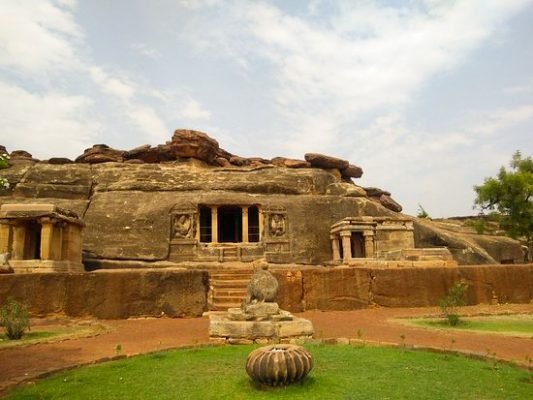
Anti-hero for many, Hero for others – one of the most iconic characters in Hindu mythology is Ravana. The 10 headed scholar and an ardent devotee of Lord Shiva, is said to have facilitated the construction of Ravana Pahad.
Built-in the 6th century, it is one of the earliest known structures to have been built around Badami. Ravana Pahad is dedicated to Lord Shiva. This is quite evident through the way it has been constructed as well. A figure of Nandi carved completely out of one stone welcomes the visitor to the cave. The exteriors adorn four pillars that lead to the cave with relief sculptures of Shiv-Parvathi. Extensively carved and designed with the utmost care, the Shiv-Parvathi sculpture is a true piece of skilled craftsmanship.
Alongside this, the cave also has a mandapa with bas-relief sculptures of the several avatars of Vishnu – one among the Trimurthis.
Accompanying this is the artistic sculptures of the third among the Trimurthis – Shiva.
The temple is easily locatable from the north of the Aihole temple complex. Different from the temple-like structures in Aihole is this cave dedicated to the God of destruction.
10. Akka Tangi falls

The perfect spot to chill around during the early hours of sunrise, Akka Tangi falls was a shift from the rustic nature of the town to a fresher side of it.
Ideal to be visited post-monsoon, the falls are open to visit till 5’30 pm.
It’s barely a kilometre from the Badami main bus stand and is situated right atop the Bhutanatha group of temples.
There isn’t much of a crowd during early morning hours, but later on, bunches of pilgrims come by to wash their feet before entering the temple premises.
There wasn’t much history attached to it that the localites could narrate but they referred to the idea of the waterfalls being sisters. Hence the name Akka (elder sister) Thangi (younger sister) falls.
The falls aren’t heavy and it’s easily accessible. There was a long period of the dry spell, which was compensated for with the long due rains.
Post monsoon the falls are a spectacular sight and creates a ‘Jalapath’. Walking amidst it felt like the most perfect way to end the Badami trip.
So take off to this offbeat getaway destination and explore the timeless gems of Badami!




